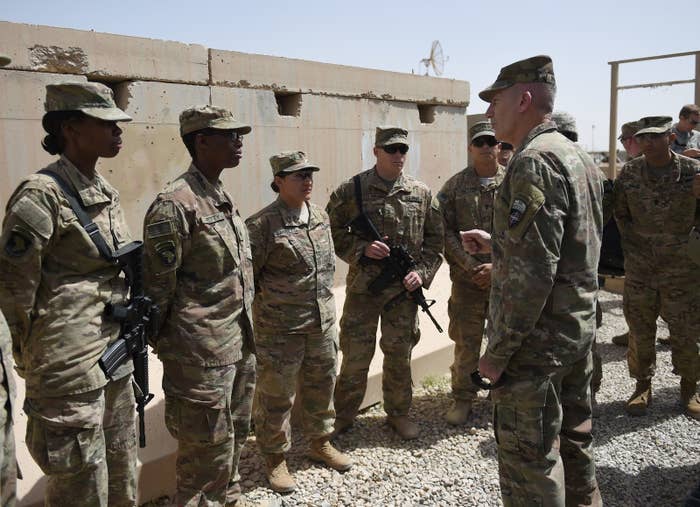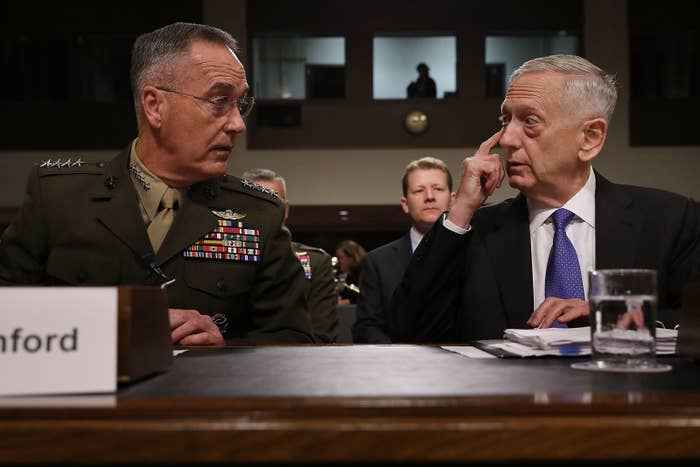
Secretary of Defense Jim Mattis signaled on Wednesday that not only does the Pentagon have a unilateral say over if and when new US troops deploy to Afghanistan, but that it will have a major say in military strategy there as well, leaving critics wary of a commander in chief who shows no interest in commanding.
Under a new authority provided by President Donald Trump on Tuesday and first reported by BuzzFeed News, Mattis will have the final say over how many troops will be sent to Afghanistan, where the US has been fighting a war since 2001. In April, the president granted Mattis the same authorities in Iraq and Syria. Before those changes, such decisions were closely held by the White House. Mattis can now greatly deepen American involvement without having to go to the president.
“This decision is part of a broader strategy we are developing that addresses our role in Afghanistan and beyond. We will present this to the President in the coming weeks. We will continue to work with our allies and we will ask more of them,” Mattis said in a statement.
While testifying on Capitol Hill about the defense budget on Wednesday, Mattis offered the Trump administration's most detailed objectives for the war yet, promising a strategy within weeks. The White House has yet to offer a strategic goal for Afghanistan, other than to call for the defeat of ISIS and al-Qaeda. Trump has yet to speak to the general in charge of the war, even as his administration has spent eight weeks reviewing its position in Afghanistan.
A new strategy seems badly needed. Even though the war is approaching its 16th year, senators were still asking fundamental questions about the US effort on Wednesday.
“How do you define victory?” Sen. Jon Tester asked Mattis. Mattis responded that the US military strategy seeks to lower the levels of violence in Afghanistan to a point that can be contained by local troops, all under a respected Afghan government. That, he said, would ensure there will be no safe havens from which terrorists can plot attacks on the West.
The defense secretary, however, stopped short of giving a timeline for achieving that, or did not say if there would be one.

Mattis confirmed his new authority during his testimony on Wednesday. "At noon yesterday, President Trump delegated to me the authority to manage troop numbers in Afghanistan," Mattis told the committee, adding the new authority “does not at this time change the troop numbers for Afghanistan."
The new authority “assures the department can facilitate our missions and nimbly align our commitment to the situation on the ground," Mattis said.
Rather than saying how many troops are headed to Afghanistan, the Pentagon will, going forward, announce the kind of troops deploying and the approximate size of the unit. Under the Obama administration there were caps on the total number of troops deployed in Iraq and Afghanistan. At times, that meant that only parts of a military unit could be in a war zone at a given time.
Under repeated questioning by Sen. John McCain at a prior hearing on Tuesday, Mattis said the department was crafting a strategy and would put something forward by next month. Army Gen. John Nicholson, the top US commander for the war effort in Afghanistan, has asked for roughly 3,000 additional troops in Afghanistan. The additional troops would allow US military advisers to embed with their Afghan counterparts at a lower level, defense officials have said.
There are officially 8,400 US troops currently deployed in Afghanistan, with at least an additional 1,000 troops, including special operations forces, not counted in the official tally. Roughly 3,000 NATO troops are also taking part in the operation to secure Afghanistan.
Going forward, Pentagon officials foresee an approach similar to the US decision to launch 59 Tomahawk missiles at a Syrian airfield in April. The president will broadly state what he wants to see happen, and top military and national security officials will craft a response, with relatively little input from civilian leadership.
But, critics argue, a Pentagon that controls both deployments and overall strategy portends an overly hands-off approach by the commander in chief. As one Pentagon official said, “Deployments are not a strategy.”
The administration has laid out such broad objectives for the US intervention “that for all practical purposes the president is forfeiting control of policy,” said Andrew Bacevich, professor emeritus of history and international relations at Boston University and a retired Army colonel.
Even inside the Pentagon, some fear that the shift in authority will allow Trump to wash his hands of a failing war effort. The Taliban has increasingly taken urban areas, and ISIS controls at least three districts. Nicholson has called the war in Afghanistan a stalemate. On Tuesday, Mattis declared the US is “not winning” in Afghanistan.
“Intuitively Trump may well understand that Afghanistan is a misbegotten enterprise,” Bacevich, a longtime critic of the post-9/11 wars, said. “Who’s in charge? The commander in chief is choosing not to be in charge.”
The Trump administration's decision to allow the US military to determine when and how many troops to send to Afghanistan, Iraq and Syria marks the greatest change in how the US military and civilian leadership has determined deployments in 70 years, Bacevich said.
Ever since US troops attempted to cross the 38th parallel during the Korean War, going beyond the conflict’s original aims, presidents have taken a more hands-on approach to how the US deploys its military to war zones, Bacevich told BuzzFeed News.
The shift to give the military leeway wasn’t seen as a bad thing by all observers, however.
“I’m really pleased that this president is listening to those who understand wars,” Sen. Lindsey Graham told Mattis on Wednesday.

